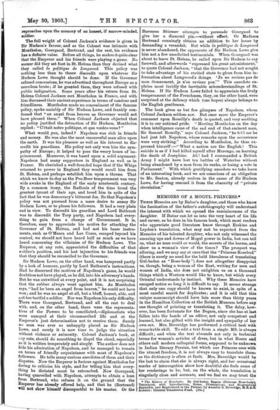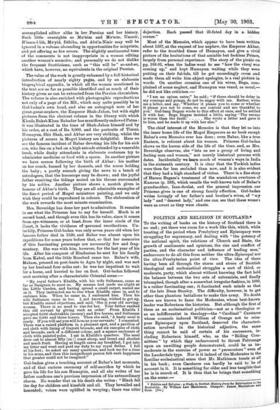MEMOIRS OF A MOGUL PRINCESS.*
Tunas Memoirs are by Babar'a daughter, and those who knot the fascination of the father's autobiography will understand the interest with which we opened the reminiscenoes of the daughter. If Babar can let us into the very heart of his lib and career, as he does in his famous book, which most readers who appreciate good literature know through Erskine and Leyden's translation, what may not be expected from the Memoirs of his talented daughter, who not only witnessed the amazing ups and downs of Mogul power in India, but can tell us, what no man could or would, the secrets of the harem, and show us a woman's view of the times? The prospect wag alluring, and we may say at once that the "Princess Rosebud" (there is surely no need for the bald literalness of translating Gul-badan as "Rose-body ") does not altogether disappoint us, though, being a woman of the East, writing for men and women of India, she does not enlighten us on a thousand things which a Western would like to know, but which every Oriental understands by instinct. Why these Memoirs have escaped notice so long it is difficult to say. It seems strange that only one copy should be known to exist, in spite of most careful search for duplicates; and it is odd that this unique manuscript should have lain more than thirty yeah in the Hamilton Collection at the British Museum before any one thought of printing or translating it. The delay, how- ever, has been fortunate for the Begam, since she has at lash fallen into the hands of an editor, not only competent an learned, but also gifted with the insight and sympathy of bee own sex. Mrs. Beveridge has performed a critical task with remarkable skill. To edit a text from a single MS. is always. difficult; and when the text abounds not only in technical terms for women's articles of dress, but in what Rosen ays4 others call modern colloquial forms, supposed to be unknown in Indian literary Persian, but which our Princess uses with the utmost freedom, it is not always easy to translate them, as the dictionary is often at fault. Mrs. Beveridge would be the last to claim that she is always right, and her occasional marks of interrogation show how doubtful she feels some of her renderings to be; but, on the whole, the translation 44 singularly close and accurate, and we feel we may trust the • The History of HusulyAn. By Out.badan Begain (Princess Bose-bothh Translated, with Introduction, Notes, Illustrations, and Biographicoal Appendix, and Reproduced in the Persian, by Annette B. Beveridge, ILE.A.ft Loudon Oriental Translation Fund. [10s.]
accomplished editor alike in her .Persian and her history. Such little oversights as Mienim and Mu`nim, Umara', fathiha, and Abien-Nasir may well be ignored in a volume abounding in opportunities for misprints, and yet offering so few errors. The slightly sentimental tone of the comments is not inappropriate in a woman editing another woman's memoirs; and personally we do not dislike the frequent Scotticism, such as "this will be" so-and-so, which have, however, no equivalents in the original Persian.
The value of the work is greatly enhanced by a full historical introduction of nearly eighty pages, and by an elaborate biographical appendix, in which all the women mentioned in the text are as far as possible identified and as much of their history given as can be extracted from the Persian chroniclers. The volume is also enriched with photographic reproductions not only of a page of the MS., which may quite possibly be in Gul-kadan's own hand, and also an autograph note of her great-great-nephew, the Emperor Shah-Jahan, but with eight pictures from the choicest volume in the library with which Khuda Baksh Khan Bahadur has munificently endowed Patna : it was illustrated in the time of Shah-Jahan himself and by his order, at a cost of Rs. 8,000, and the portraits of Timur, Humayun, Shir Shah, and Akbar are very striking, whilst the pictures of scenes in Mogul history are delightful. Here we see the famous incident of Babar devoting his life for his sick son, who lies on a bed on a high esti ade attended by a venerable leech, while dusky attendants in elaborate costumes try to administer medicine or food with a spoon. In another picture we have scenes following the birth of Akbar : his mother on her couch, fanned by her damsels, and the nurse holding the baby ; a portly eunuch giving the news to a bench of astrologers, that the horoscope may be drawn; and the joyful father receiving the tidings seated on his throne surrounded by his nobles. Another picture shows a nautch given in honour of Akbar's birth. They are all admirable examples of the finest period of Mogul miniature painting, and we only wish they could be reproduced in colours. The elaboration of the work rewards the most minute examination.
Mrs. Beveridge has done her part to admiration. It remains to see what the Prinoess has to say for herself. Much is at second hand, and though even this has its value, since it comes from eye-witnesses, or at least the inner circle of the Court, it lacks the vividness of -personal recollections. Un- luckily, Princess Gul-badan was only seven years old when her famous father died in 1530, and Babar was absent upon his expeditions for some years before that, so that her memories of this fascinating personage are necessarily few and frag- mentary. She was with him, however, for the last year of his life. After his conquest of Hindustan he sent for his family from Kabul, and the little Rosebud came too. Babar's wife, Maham, pressed on post-haste to Agra by night, and was met by her husband four miles out : he was too impatient to wait for a horse, and hurried to her on foot. Gul-badan followed next morning after a characteristic Oriental scene :—
" My royal father's Khalifa, with his wife Sultanam, came as far as Nau,„oTam to meet us. My mamas had made me alight at the Little Garden, and having spread a small carpet, seated me on it. They instructed me to rise when Khalifs came in, and to embrace him. When he came in, I embraced him. Then his wife Sultaiaam came in too. I, not knowing, wished to get up, but Khalifa raised objections, and said, She is your old serving- woman. There is no need to rise for her. Your father exalted this old servant by giving such an order.' From Khalifa I accepted 6,000 shahrukhis (money) and five horses, and Sultanam gave me 3,000 and three horses. Then she said, A hasty meal is ready. If you will eat you will honour your servants.' I consented. There was a raised platform in a pleasant spot, and a pavilion of red cloth with lining of Gujrati brocade, and six canopies of cloth and brocade, each of a different colour, and a square enclosure of cloth with painted poles. I sat in Khalifa's quarters. The meal drew out to almost fifty [sic!] roast sheep, and bread and sherbet and much fruit. Having at length eaten my breakfast, I got into my litter and went and paid my duty to my royal father. I fell at his feet ; he asked me many questions, and took me for a time in his arms, and then this insignificant person felt such happiness that greater could not be imagined."
Gul-badan gives a touching account of Babar's last moments, and of that curious ceremony. of self-sacrifice by which he gave his life for his son Humayun, and all she writes of her father confirms one's previous impression of his extraordinary charm. No wonder that on his death she writes : " Black fell the day for children and kinsfolk and all. They bewailed and lamented; voices were uplifted in weeping ; there was utter dejection. Each passed- that ill-fated day in a hidden corner."
Most of the Memoirs, which appear .to have been written about 1587, at the request of her nephew, the Emperor Akbar, refer to the troubled times of Humayun, and give a vivid picture of the hesitations of that amiable but feckless Prince, largely from personal experience. The story of the picnic on pp. 188.91, when the ladies went to see " how the riwaj was coming up," and kept Humayun waiting while they were putting on their fal-lals, till he got exceedingly cross and made them all write him abject apologies, is a real picture in words. On another occasion one of his wives, Bega, coin- plained of some neglect, and Humayun was vexed, as usual,— he did not like criticism :-
" I am an opium eater," he said ; "if there should be delay in my comings and goings, do not be angry with me. Rather, write me a letter, and say, Whether it please you to come or whether it please you not to come, we are content and are thankful to you.' Gul-barg Begam wrote to this effect at once, and he settled it with her. Bega Begam insisted a little, saying The excuse is worse than the fault.' . . . . . She wrote a letter and gave it to him, and he made it up with her also."
The chief interest of the Memoirs is that they let us into the inner home life of the Mogul Emperors as no book except Babar's own Memoirs ever has done ; even Babar, like a true Eastern, is reticent about his women. Princess Gul-badau shows us the harem side of the life of the time, and, as Mrs. Beveridge observes, she "lets us see a group of living and feeling men and women," not merely historical persons with dates. Incidentally we learn much of women's ways in India in the sixteenth century. It is clear that the Turkish ladies were then far less secluded than now, and it is also evident that they had a high standard of virtue. There is a fine story of Haram Begam's treatment of the scandalous overtures of Kamran (p. 193), which recalls the well-known tale of Babar's grandmother, Isan-daulat, and the general impression our Princess gives is one of strong family affection. Gul-badan writes lovingly of her father's and brother's wives, of "my lady " and " dearest lady," and one can see that these wome
were as sweet as they were chaste.







































 Previous page
Previous page